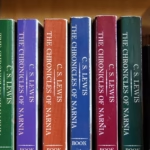Read every series in the right order

The Leaf Thief Books in Chronological Order – Complete Reading Guide
Table of Contents
Quick Answer (TL;DR)
If you want a smooth, season-by-season journey through Squirrel and Bird’s world, read the Leaf Thief picture books in seasonal order: Spring (That’s MY Flower! / Don’t Touch That Flower!), Summer (The Sun Thief), Autumn (The Leaf Thief), and Winter (The Snow Thief). Families with toddlers can weave in the concept board books (Colours, Numbers) and interactive titles (Where’s the Leaf Thief?) anytime. This order reinforces nature’s cycle and gently coaches kids through change, patience, and problem-solving—perfect for story time, circle time, and early science units.
Introduction
At Books in Chronological Order, we love a picture-book series that does more than deliver giggles. The Leaf Thief universe—written by Alice Hemming and illustrated by Nicola Slater—wraps early science learning (seasons, day length, nocturnal animals) inside warm, funny stories about a very earnest Squirrel and a very patient Bird. Each book balances humor with heart, helping young readers navigate change—from leaves falling to days shortening—without ever feeling lectured.
Parents, teachers, librarians, and homeschoolers often ask us the best way to approach the series: publication order or story-world order? Because these books mirror the cycle of the year, we recommend a chronological (seasonal) reading order for the strongest comprehension and SEL (social-emotional learning) payoff. Below we map that out, show where the novelty board books fit, and share tips to turn these charming reads into cross-curricular mini-units.
Quick Facts
| Field | Details |
|---|---|
| Series | The Leaf Thief (9 books including picture books, novelty board books, and new 2025 releases) |
| Author / Illustrator | Alice Hemming / Nicola Slater |
| Typical Pages | 32–40 pages (picture books); 10–20 pages (board books) |
| Average Read Time | 6–10 minutes per picture book; 2–5 minutes per board book |
| Reading Difficulty | Easy (read-aloud ages 3–7; emergent readers 6–8 can try shared reading) |
| Genres | Children’s Picture Book, Humor, Nature/Seasons, Animals |
| Content Notes | Very mild peril/anxiety for laughs (Squirrel worries!); always resolved gently |
| Media Adaptations | None announced (print & ebook/Kindle available; some markets offer read-aloud video editions via publishers/retailers) |
| Ideal Age Range | 3–7 (great for Pre-K to Grade 2; board books ideal for toddlers 2–4) |
About The Leaf Thief Book Series
Squirrel loves his tree. He loves his leaves. He loves his perfectly predictable forest—until something changes. A missing leaf. A flower that needs “protecting.” Snow that vanishes. Sunlight that lingers a little too long…or disappears too soon. Every book builds a simple science concept into a cozy, comedic mystery: Is there a thief? Bird—equal parts mentor, bestie, and voice of reason—helps Squirrel reframe what’s happening through inquiry and observation. The result: a sweet blend of STEM, SEL, and big-laugh read-aloud moments.
Why families and educators adore it
- Predictable structure kids latch onto (set-up → mystery → gentle discovery → happy resolution).
- Curriculum-friendly: seasons, daylight, nocturnal animals, patience, sharing.
- Visual charm: Nicola Slater’s bright, expressive art makes emotions easy to read and discuss.
- Re-read value: Children love spotting visual jokes and “clues” earlier on pages.
The Leaf Thief Books at a Glance
Tip: We include search links so you can choose Paperback / Hardcover / Kindle editions available in your region.
| # | Title (Year / Edition) | Amazon Buy Links |
|---|---|---|
| 1 | The Leaf Thief (2021) | Buy On Amazon |
| 2 | That’s MY Flower (PB, 2023; UK origin) | Buy On Amazon |
| 3 | Don’t Touch That Flower! (US edition, 2023) | Buy On Amazon |
| 4 | The Snow Thief (PB/HC) | Buy On Amazon |
| 5 | The Sun Thief (June 5, 2025) | Buy On Amazon |
| 6 | Where’s the Leaf Thief? (Aug 5, 2025; felt-flap board book) | Buy On Amazon |
| 7 | The Flower Thief (Aug 14, 2025; retitled board/HC of spring story) | Buy On Amazon |
| 8 | The Leaf Thief — Colours (Lift-the-Flap Board) | Buy On Amazon |
| 9 | The Leaf Thief — Numbers (Lift-the-Flap Board) | Buy On Amazon |
The Leaf Thief Books in Chronological Order (detailed blurbs)
We recommend this seasonal order for the most natural learning arc and character growth.
1) Spring — That’s MY Flower! (also published as Don’t Touch That Flower!)
Theme: Sharing, patience, plant growth
Classroom tie-ins: Plant life cycles; parts of a flower; “being gentle” with living things
What to watch for: Squirrel’s protective instincts are understandable—he remembers when the leaves “disappeared.” Children identify with wanting to keep something beautiful “safe,” which opens a conversation about boundaries, care, and trust.
Read-aloud prompt:
- What do plants need to grow?
- Whose job is it to “guard” nature—and what does “helping” look like?
2) Summer — The Sun Thief (2025)
Theme: Day length, nocturnal animals, sleep routines
Classroom tie-ins: Light vs. dark; longest/shortest days; diurnal vs. nocturnal habits
What to watch for: Squirrel thinks there must be a “sun thief” as bedtime gets weird. Bird helps him discover that daylight changes across the year. Kids love meeting nocturnal friends and talking about who’s awake when.
Read-aloud prompt:
- Why does the sun seem to stay up later in summer?
- Which animals like the night? What do they do?
3) Autumn — The Leaf Thief (2021; NYT Bestseller)
Theme: Seasonal change, anxiety regulation, observation
Classroom tie-ins: Why leaves change color; weather patterns; wind as a force
What to watch for: The “mystery” of missing leaves frames a gentle science lesson: trees prepare for winter. The humor keeps worries light, while the reveal reassures children that change is normal.
Read-aloud prompt:
- What colors do we see now vs. in spring?
- Can you “hear” fall in the illustrations—rustling leaves, blustery wind?
4) Winter — The Snow Thief
Theme: Impermanence, water cycle (melting), resilience
Classroom tie-ins: States of matter; what makes snow; temperature & melting
What to watch for: As the snow “disappears,” Squirrel suspects a thief—again. Cue Bird with a simple weather mini-lesson. Children experience cause and effect visually and practice coping with change.
Read-aloud prompt:
- Where does snow go when it melts?
- How can we make winter fun even when snow isn’t here?
Bonus: The Concept & Interactive Books (slot these anywhere!)
- Where’s the Leaf Thief? (felt-flap board book) — great fine-motor practice and object permanence.
- The Leaf Thief — Colours (lift-the-flap) — color vocabulary with familiar characters.
- The Leaf Thief — Numbers (lift-the-flap) — counting practice within the forest world.
- The Flower Thief (2025) — a spring-themed, retitled edition that pairs neatly with That’s MY Flower! for comparative reading.
Series Timeline & Character Development
Squirrel begins as a lovable ball of nerves: vigilant, protective, and quick to imagine culprits. Across the seasons he learns to ask questions, wait, and observe before reacting. His biggest growth comes from:
- Spring → Summer: trading “guarding” for care and curiosity; noticing routines (bedtimes, daylight).
- Autumn → Winter: accepting impermanence—leaves and snow come and go.
- Across all books: learning self-regulation (deep breaths, listening, trying again) modeled through Bird’s calm coaching.
Bird is Squirrel’s trusted guide, modeling scaffolding: never scolding, always guiding with a question, an invitation to notice, and a gentle bit of info at the end. Bird’s approach is a SEL masterclass for grown-ups: validate the feeling → spark observation → co-discover the answer.
Novels Sorted in Order of In-Universe Events
- That’s MY Flower! / Don’t Touch That Flower! — Spring
- The Sun Thief — Summer
- The Leaf Thief — Autumn
- The Snow Thief — Winter
- Where’s the Leaf Thief? — Interactive side-quest (fits anywhere)
- The Flower Thief — Spring retitle/edition (works with #1)
- Colours — Concept board (anytime)
- Numbers — Concept board (anytime)
Note: Titles 2, 5, and 6 are 2025 additions; availability may vary by region/format.
Novels Sorted in Order of Publication
- The Leaf Thief (2021)
- That’s MY Flower! (PB, 2023) / Don’t Touch That Flower! (2023, US)
- The Snow Thief (PB/HC)
- The Sun Thief (June 5, 2025)
- Where’s the Leaf Thief? (Aug 5, 2025)
- The Flower Thief (Aug 14, 2025)
- The Leaf Thief — Colours (board)
- The Leaf Thief — Numbers (board)
(Concept board books often publish parallel to the mainline picture books; exact regional pub dates can differ.)
Companion Works
- Classroom & Story-time Enhancers:
- Nature journals (draw a leaf/flower each week).
- Window “daylight tracker” (mark sunset time for a month).
- Melt-a-snowball demo (ice in a bowl) tied to The Snow Thief.
- “Forest friends” role play (nocturnal vs. diurnal).
- Pairing Suggestions:
- Fletcher and the Falling Leaves (autumn feelings)
- Good Night, Owl! (sound & sleep)
- Any simple plant-growing kit for That’s MY Flower! week.
Editions & Formats (hardcover, collector, audio)
- Hardcover & Paperback: Best for read-aloud longevity in classrooms and libraries.
- Board Books (Colours, Numbers, Where’s the Leaf Thief?): Built for toddlers; interactive flaps support fine-motor skills and attention.
- Kindle/E-book: Handy for travel and projection; double-tap zoom helps with “find the clue” moments.
- Audio: Market-dependent; when available, use as listening center material paired with print copies so children can track text and images.
Collector tip: Look for editions with back-matter—a single spread of kid-friendly science facts about seasons, daylight, and nocturnal animals to anchor discussion.
Why Read The Leaf Thief Books in Chronological Order?
Reading The Leaf Thief Books in Chronological Order (Spring → Summer → Autumn → Winter) gives children a clear, circular pattern:
- Predict & Connect: Kids begin to expect what each season brings (flowers → long days → changing leaves → snow).
- Science Meets Story: Cause-and-effect gets anchored in concrete visuals.
- Feelings Are Information: Squirrel’s worries are treated as useful clues that point to questions we can answer.
- Memory Building: Running jokes and visual callbacks grow the child’s confidence on re-reads.
Short on time? Start with The Leaf Thief, then loop back to Spring with That’s MY Flower!—kids love the “Ohhh, that’s why!” moment when they connect Squirrel’s leaf worries to his spring protectiveness.
Author Spotlight: Alice Hemming (with Nicola Slater)
Alice Hemming began her career as a librarian and web content editor (we love a kindred spirit!), then shifted to writing during maternity leave—and never looked back. She’s now published 50+ books across picture books and middle grade, with a special knack for playful dialogue and folklore-flavored charm for older readers. Alice lives in Hertfordshire, UK, where a garden writing shed fuels her imaginative, child-centered storytelling.
Nicola Slater brings the heart. Her expressive character design—Squirrel’s big feelings, Bird’s calm patience—translates emotional beats even for pre-readers. Slater’s color palettes help signal the season and mood, which makes these books ideal for visual literacy lessons.
Why this duo works: Hemming’s tight, funny scripts + Slater’s warm visual cues = a reliable read-aloud rhythm you can return to all year.
Media Adaptations (films, TV, radio)
None formally announced at this time. If/when short animated read-alouds or audio editions appear in your market, they’re best used with the books—so children still see the illustrations where the “clues” live.
FAQs
What age are the Leaf Thief books best for?
Ages 3–7 is the sweet spot. Board books (Colours, Numbers, Where’s the Leaf Thief?) also land beautifully with toddlers (2–4).
Can I read them out of order?
Absolutely. Each picture book stands alone. We recommend chronological reading to reinforce seasons, but it’s not required.
Is it scary?
No. Squirrel worries, but the tone is giggly and gentle. Bird’s guidance keeps things safe and reassuring.
Are the board books “extra,” or do I need them to follow the story?
They’re extras—great for concept practice and hands-on fun. Read them anytime.
Spring book confusion: That’s MY Flower vs. Don’t Touch That Flower vs. The Flower Thief?
Different markets/editions sometimes carry variant titles and formats for the spring story. Treat them as spring companions; choose the edition available to you.
Final Thoughts
The Leaf Thief Books in Chronological Order are more than seasonal stories; they are kid-sized science told with humor, kindness, and the most relatable anxiety-prone hero since…well, most of us before coffee. Whether you’re a parent seeking calm-down reads, a teacher building a seasons unit, or a librarian curating a fall display, Squirrel and Bird have a spot on your shelf all year long.
Teacher tip: How do I turn this into a mini-unit?
- Monday/Tuesday: read the book twice; Wednesday: do the science mini-exploration; Thursday: draw/write in a nature journal; Friday: “drama corner” role play (Squirrel, Bird, Nocturnal Friends).
- Add vocabulary: nocturnal, diurnal, bud, bloom, melt, breeze, season, daylight.







